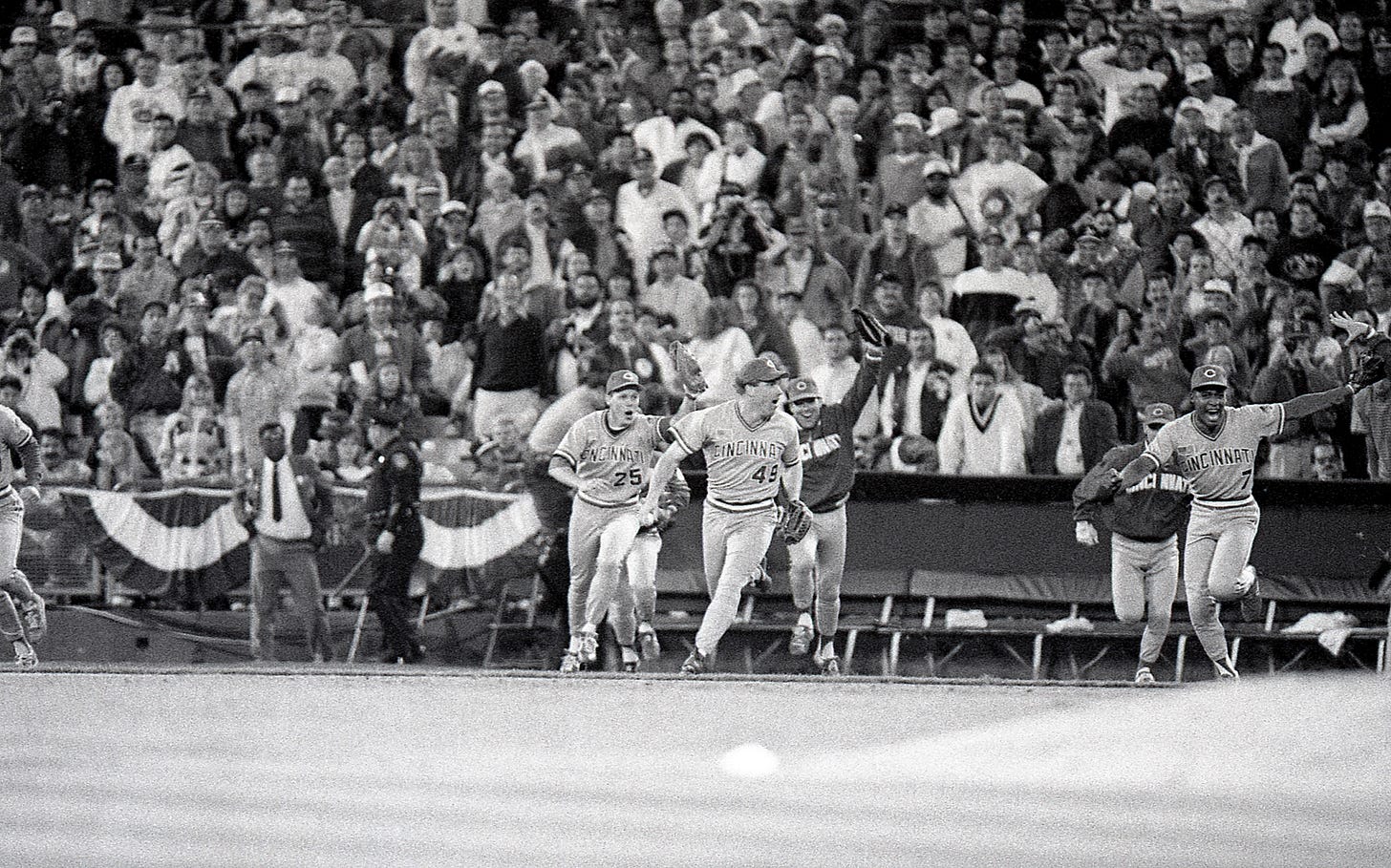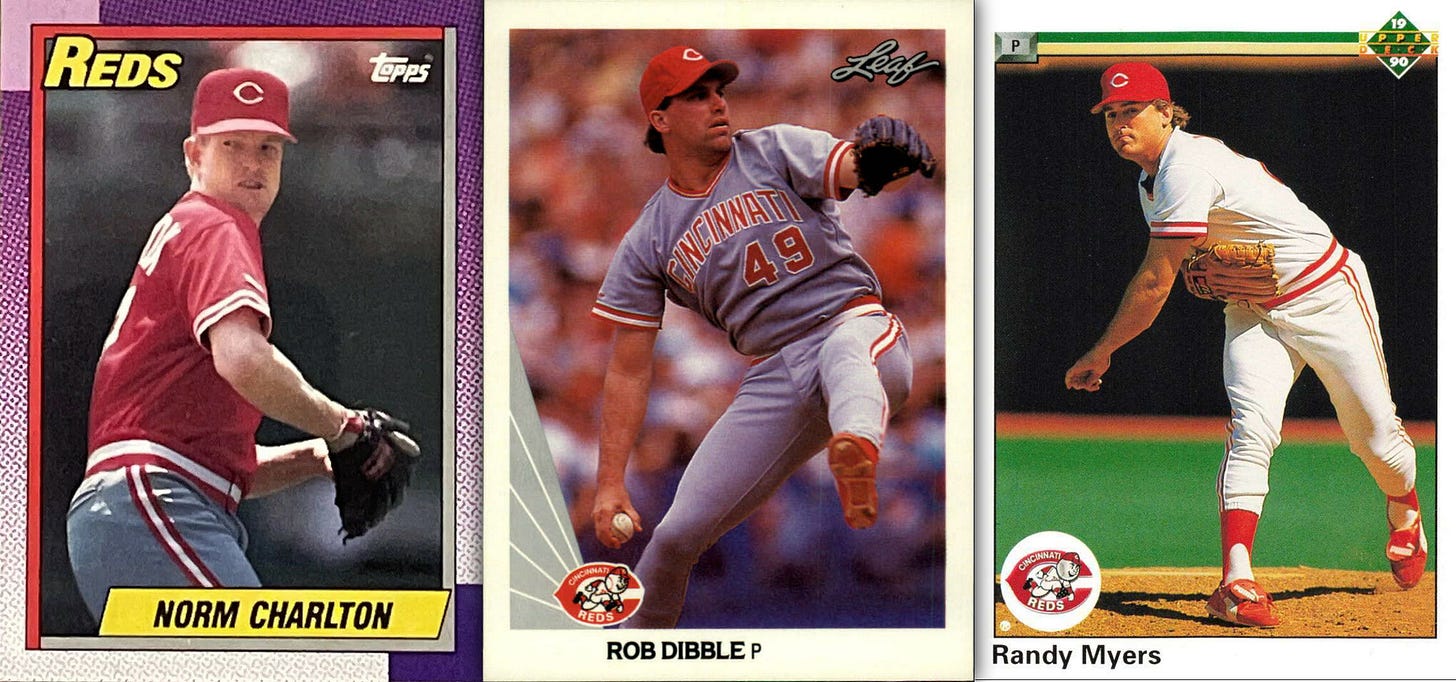The Nasty Boys tormented the league with their pitches and punches
Rob Dibble, Norm Charlton and Randy Myers were brash, bold, braggadocious and brazen -- and very dominant for the early 1990s Reds.
Good is bad, and bad is good.
And the Cincinnati Reds relievers of the early 1990s -- led by the triumvirate of Rob Dibble, Norm Charlton and Randy Myers -- were nasty.
Relievers don't often get a lot of attention on a baseball team. The starters do the heavy lifting, and the relief pitchers are there not to screw it up.
Rarer still are the relief staffs that have their own persona. Sure, lockdown closers like Mariano Rivera and Trevor Hoffman are great, but you could pretty much switch out their set-up men without much thought because the back end was so secure.
The Nasty Boys, as they came to be known, were brash, bold, braggadocious and brazen. They blew smoke by you. And they weren't afraid to knock you down or throw a punch if it was required. Which only made them scarier to face.

The Nasty Boys established themselves at the start of the lockout-delayed 1990 season, which began for the Reds on April 9 in Houston.
Glenn Davis was the best power hitter in the Astros' lineup, and in the opening game, he got plunked three times -- twice by starter Tom Browning, and once by Myers. Cincinnati won the game 8-4, setting a tone for the wire-to-wire champions while also deepening the team's rivalry with Houston.
"There was some talk of reporters saying that they were gonna retaliate," Charlton told me in a 2014 interview. "We were kinda like, 'well, if that's what they want to do, go ahead. We got three guys throwing 95-plus.'
"They hit somebody in the short future and we hit somebody else, and it kind of escalated from there."
Each of the Nasty Boys brought their own personality and swagger to the mound. Dibble, a Bridgeport, Connecticut native, didn't like being shown up. Or bunted on. Doug Dascenzo found that out the hard way, plunked by a ball as he ran to first on a bunt Dibble fielded. Dibble didn't even bother trying to throw the ball to the first baseman. Tim Teufel, meanwhile, got a heater square in the back for getting a few hits off of Dibble.
Charlton, a triple-major at Rice (political science, religion and physical education) was the brains of the group, with an arsenal that included a fastball, curveball and forkball. He also didn't mind a good dust-up, like the time he went out of his way to bowl over Mike Scioscia on a play at the plate.
Myers, acquired in a trade with the Mets, was a wild card known to bring hand grenades or his stun gun into the locker room (he'd zap people with it for fun).
The Nasty Boys zapped opponents' late-game chances in 1990 and effectively shortened Reds' games to five or six innings. They combined to win 24 games and save 44 others with a 2.28 ERA in 338 innings pitched. All three finished with 3.0 or greater WAR, and Dibble and Myers were all-stars.
Behind the dominant bullpen and a solid lineup, Cincinnati won its first pennant since the Big Red Machine in 1976. The 1990 team was so confident, the players recorded the rap "Reds Hot," well before winning the title -- the song was credited to B-Lark and the Homeboys.
The Reds faced off against the defending champs, the Oakland Athletics, in the World Series. Oakland was expected to steamroll the Reds.
But Cincinnati didn't buckle. And behind strong pitching from Jose Rijo, and timely hitting from Billy Hatcher, and the Nasty Boys closing the door, the Reds were world champions in four games.


The fighting spirit continued in the seasons that followed. One of the Nasty Boys' biggest brawls came on April 11, 1991 against the Astros, after Dibble threw behind Houston's Eric Yelding.
Dibble was aiming for payback after giving up an RBI single to pitcher Curt Schilling.
Yelding immediately took off toward the mound, and Dibble was ready, stepping toward home plate, tossing his glove aside and assuming a fighting stance.
Yelding tried to throw his helmet at Dibble and was quickly tackled as players from both teams rushed to join the fight.
Batters entered the box in fear when one of the Nasty Boys was on the mound.
That was the case with Ken Caminiti, then of the Astros, who couldn't get a hit off of Charlton, a friend who he'd teamed with years earlier on Team USA. Through the 1991 season, Ken was 0-for-22 against Charlton. The pair belonged to the same hunting club.
"We were all, about six or eight of us, sitting around a table at our hunting club. And they were teasing Ken about not being able to get a hit off me," Charlton said.
"I was always worried he's gonna hit me," Ken said.
"Ken, I promise you I won't hit you in the head, I promise you," Charlton told him.
The teams faced off early the following season, and in Ken's very next at-bat against Charlton, down 5-1 with two men on base, he slugged a clutch ninth inning home run, the key hit in a 6-5 comeback win.
As Ken rounded the bases, Charlton's armistice was over: "all bets are off now," he said. Ken would never get another hit off of Charlton, finishing 1-for-31 against him in his career.
The bad blood between the Astros and Reds spilled over (again) during a June 24, 1992 game after Houston's Pete Harnisch threw behind Reggie Sanders, causing Dibble and Cincinnati's Glenn Braggs to come out on the field.
Dibble and Astros catcher Scott Servais were going at it when Houston coach Ed Ott stepped in, putting Dibble in a chokehold -- and nearly killing him.
"I watched him turn red, I watched him turn purple, I watched him turn blue, then I let him up," Ott said at the time. "Maybe now, he'll value life. He doesn't know how much damage he can do throwing a 100-miles-per-hour fastball at somebody . . . maybe he's learning.
"I could have given another 45 seconds and watched him turn black. But I let him up."
Reds outfielder Bip Roberts recalled the fight, and the Reds-Astros rivalry, years later.
"It was just one of the craziest things in the world. I didn't realize it was such a rivalry until I got into that uniform," Roberts told me.
"Ed Ott on the mound, I thought he was gonna choke Dibble out. He started turning purple, and I look over to first base and Bagwell tried to go grab Glenn Braggs and he had his uniform over his head. I'm like, 'what is going on out here? Where did this come from?'"
That was simply how the Nasty Boys operated. The league's bad boy bullpen didn't hold back — on their pitches or punches.


